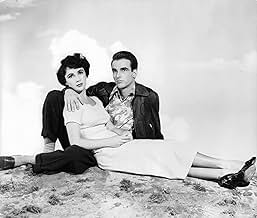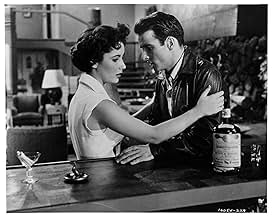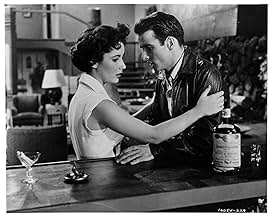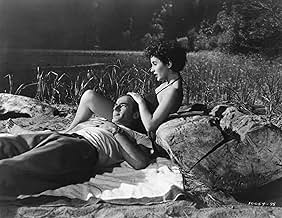CALIFICACIÓN DE IMDb
7.7/10
26 k
TU CALIFICACIÓN
Un niño pobre consigue un trabajo para su tío rico que termina enamorándose de dos mujeres.Un niño pobre consigue un trabajo para su tío rico que termina enamorándose de dos mujeres.Un niño pobre consigue un trabajo para su tío rico que termina enamorándose de dos mujeres.
- Dirección
- Guionistas
- Elenco
- Ganó 6 premios Óscar
- 18 premios ganados y 12 nominaciones en total
Robert J. Anderson
- Eagle Scout
- (sin créditos)
Gertrude Astor
- Bit Part
- (sin créditos)
Opiniones destacadas
I can only say that George Stevens' version of Theodore Dreiser's "An American Tragedy" is not what I envisioned when I read the book. Therefore, I came away disappointed at the screen treatment with Liz Taylor (beautiful but shallow), Montgomery Clift (beautiful but shallow) and poor Shelley Winters looking like a drab little wren. An air of artificiality hangs over every scene, every slow-moving scene, and only increases by the time the story arrives at the courtroom climax where an unrestrained Raymond Burr is allowed to chew the scenery.
This is NOT the great picture everyone always says it is. It's one of those films that dates badly. Evidently, fans of Liz Taylor and Monty Clift are starry-eyed about their favorite actors and refuse to see the weaknesses in the plodding story and the thinly sketched characters. Elizabeth Taylor had much better roles in her future career (Cat On a Hot Tin Roof, Giant) and Montgomery Clift would make an unforgettable Morris Townsend in The Heiress. Their acting here is as self-conscious as the arty camerawork that frames them in huge romantic close-ups.
The novel had much more depth and meaning than this watered down version of the story. Read it and you will wonder what all the fuss was about when "A Place in the Sun" was released. Vastly overrated and noteworthy only for the sincere performance of Shelley Winters and Franz Waxman's interesting background score.
This is NOT the great picture everyone always says it is. It's one of those films that dates badly. Evidently, fans of Liz Taylor and Monty Clift are starry-eyed about their favorite actors and refuse to see the weaknesses in the plodding story and the thinly sketched characters. Elizabeth Taylor had much better roles in her future career (Cat On a Hot Tin Roof, Giant) and Montgomery Clift would make an unforgettable Morris Townsend in The Heiress. Their acting here is as self-conscious as the arty camerawork that frames them in huge romantic close-ups.
The novel had much more depth and meaning than this watered down version of the story. Read it and you will wonder what all the fuss was about when "A Place in the Sun" was released. Vastly overrated and noteworthy only for the sincere performance of Shelley Winters and Franz Waxman's interesting background score.
Poor and uneducated George Eastman (Montgomery Clift) unwittingly sets a trap for himself when he takes an entry-level job at his rich uncle's factory, which has a prohibition on male employees dating female employees. He just can't resist one of the girls in his department, the pitiful and whiny Alice Tripp (wonderfully played by Shelley Winters). Eventually, George gets a promotion and is invited into the upper echelon of his uncle's social world, where he meets wealthy and beautiful Angela Vickers (a breathless Elizabeth Taylor). Naturally, he falls in love with Angela. But a complication with Alice leaves him unable to break off his relationship with her.
That's the setup for this George Stevens-directed film that plays rather like a modern Greek tragedy. Everything about "A Place In The Sun" is high quality: the production design, the lavish Edith Head costumes, the wonderful editing, and that great B&W cinematography with those marvelous close-up shots, and overlapping dissolves that cleverly advance the plot.
All three principal actors do a splendid job. And they get solid support from a top notch secondary cast that includes Raymond Burr and the interesting Anne Revere.
The story clearly plays up social class differences, with the haughty rich looking down their noses at common workers. The film's tone varies from romantic, to sad, to suspenseful. At mysterious Loon Lake where significant events occur, the cinematic atmosphere is heavy with anticipation. It's like something out of a Hitchcock thriller.
I've never cared much for sad love stories, and the film does seem a tad dated. Still, it's so well made it can be appreciated by most everyone but the terminally shallow. It has a powerful ending, one that accentuates the acting accomplishments of Clift and especially of Taylor. "A Place In The Sun" was nominated for nine academy awards, and winner of six. I'd say this is one time when Oscar voters got it right.
That's the setup for this George Stevens-directed film that plays rather like a modern Greek tragedy. Everything about "A Place In The Sun" is high quality: the production design, the lavish Edith Head costumes, the wonderful editing, and that great B&W cinematography with those marvelous close-up shots, and overlapping dissolves that cleverly advance the plot.
All three principal actors do a splendid job. And they get solid support from a top notch secondary cast that includes Raymond Burr and the interesting Anne Revere.
The story clearly plays up social class differences, with the haughty rich looking down their noses at common workers. The film's tone varies from romantic, to sad, to suspenseful. At mysterious Loon Lake where significant events occur, the cinematic atmosphere is heavy with anticipation. It's like something out of a Hitchcock thriller.
I've never cared much for sad love stories, and the film does seem a tad dated. Still, it's so well made it can be appreciated by most everyone but the terminally shallow. It has a powerful ending, one that accentuates the acting accomplishments of Clift and especially of Taylor. "A Place In The Sun" was nominated for nine academy awards, and winner of six. I'd say this is one time when Oscar voters got it right.
This 1950s melodrama was an interesting, involving story. It's part film-noir, too, which I liked. I say that because the last third of the film featured an expectation of some dreaded act about to be committed, giving it a film noir feel.
One thing for sure, whatever you label the movie: it's well-acted, well-directed and well-photographed. Regarding the latter, this really looks good on DVD. No surprise it's directed well since George Stevens was the director. His resume speaks for itself.
Obviously Montgomery Clift and Elizabeth Taylor are the "big names" in this film, but I found Shelly Winters and the character she played to be the most intriguing. She wasn't really appealing yet one could certainly identify with her feelings of insecurity with Taylor as her competition. "Liz" was in in her prime, looks-wise, with an absolutely classic face.
Anyway, watching the character studies of the antsy Winters and the troublesome Clift were interesting. Clift, as is the case with most of us, causes his own problems and things slowly unravel for him. The story is another example of what can happen when one tries to cover up the truth. It comes back to bite you, big-time!
I really found it refreshing, however, to see Clift's attitude at the end. It's the exact opposite of what you hear today. He actually takes responsibility for his actions.
One thing for sure, whatever you label the movie: it's well-acted, well-directed and well-photographed. Regarding the latter, this really looks good on DVD. No surprise it's directed well since George Stevens was the director. His resume speaks for itself.
Obviously Montgomery Clift and Elizabeth Taylor are the "big names" in this film, but I found Shelly Winters and the character she played to be the most intriguing. She wasn't really appealing yet one could certainly identify with her feelings of insecurity with Taylor as her competition. "Liz" was in in her prime, looks-wise, with an absolutely classic face.
Anyway, watching the character studies of the antsy Winters and the troublesome Clift were interesting. Clift, as is the case with most of us, causes his own problems and things slowly unravel for him. The story is another example of what can happen when one tries to cover up the truth. It comes back to bite you, big-time!
I really found it refreshing, however, to see Clift's attitude at the end. It's the exact opposite of what you hear today. He actually takes responsibility for his actions.
Time does extraordinary things with greatness. If nothing else it confirms it. "A Place in the Sun" is a remarkable example of that theory. I rushed to buy a DVD after watching a BBC documentary on ELizabeth Taylor to celebrate her 75th birthday! In "A Place on the Sun" an Elizabeth Taylor barely out of her teens is paired with Montgomery Clift. She had been raised at MGM and groomed for movie stardom from day one. He was a method actor, complex, introspective and their coupling produced something that I'm tempted to call, unrepeatable. The actors own personal stories, their friendship, mutual love and respect made it possible for their communion to be so transcendental. To make things even more perfect, the film seems a love letter from director George Stevens to his stars and vice versa. Look at the opening credits and tell me if you've ever seen a more startling introduction to a character/star. The story of doomed love and descend into darkness is, without question, one of the best ever made.
A Place in the Sun (1951)
**** (out of 4)
Oscar-winning tale of a poor boy (Montgomery Clift) who goes to work for his uncle hoping to one day be rich like him. He falls in love with a small time woman (Shelley Winters) but soon gets a taste of the society life with a beauty (Elizabeth Taylor) and this is the start of his downfall. A PLACE IN THE SUN went home with six Oscars including Best Director for George Stevens and it's easy to see why he took home the award because there's so much going on in this picture yet he holds it together perfectly. The film is part melodrama, part message film, part romance and part suspense and Stevens really brings all of it together so perfectly that you can't help but get drawn into the story and feel every bit of pain that the characters do. The most amazing thing for me, and I'm not sure if it was meant to happen this way, but I really felt a lot of sympathy for the Clift character. Again, I'm not sure if this was the filmmakers intent but no matter how much I disagreed with what he was doing at the same time I never once hated him and even to the end I was hoping things would turn his way. I think some of this credit should be given to Clift who once again turns in a remarkable performance. I thought the shyness early on, the romance with Taylor and the hatred that someone is going to take away his dreams are all things that Clift perfectly nailed. The sequence on the boat towards the end is something masterfully performed by the actor. Taylor is also extremely good in her part even though of all the main characters I think hers is the most underwritten. Winters is also very good in her role of the woman who finds herself being left behind for someone better. I thought all the scenes between her and Clift, be it romantic or fighting, were full of wonderful chemistry. Anne Revere is a standout as Clift's mother and Raymond Burr is good in his few scenes. Again, a lot of credit has to go to Stevens because every aspect of the film works. The early love story between Clift and Shelley works. The love story between Clift and Taylor works. The downright suspense on the boat at night works. Even the ending manages to work. A PLACE IN THE SUN deserves its place as an all-time classic.
**** (out of 4)
Oscar-winning tale of a poor boy (Montgomery Clift) who goes to work for his uncle hoping to one day be rich like him. He falls in love with a small time woman (Shelley Winters) but soon gets a taste of the society life with a beauty (Elizabeth Taylor) and this is the start of his downfall. A PLACE IN THE SUN went home with six Oscars including Best Director for George Stevens and it's easy to see why he took home the award because there's so much going on in this picture yet he holds it together perfectly. The film is part melodrama, part message film, part romance and part suspense and Stevens really brings all of it together so perfectly that you can't help but get drawn into the story and feel every bit of pain that the characters do. The most amazing thing for me, and I'm not sure if it was meant to happen this way, but I really felt a lot of sympathy for the Clift character. Again, I'm not sure if this was the filmmakers intent but no matter how much I disagreed with what he was doing at the same time I never once hated him and even to the end I was hoping things would turn his way. I think some of this credit should be given to Clift who once again turns in a remarkable performance. I thought the shyness early on, the romance with Taylor and the hatred that someone is going to take away his dreams are all things that Clift perfectly nailed. The sequence on the boat towards the end is something masterfully performed by the actor. Taylor is also extremely good in her part even though of all the main characters I think hers is the most underwritten. Winters is also very good in her role of the woman who finds herself being left behind for someone better. I thought all the scenes between her and Clift, be it romantic or fighting, were full of wonderful chemistry. Anne Revere is a standout as Clift's mother and Raymond Burr is good in his few scenes. Again, a lot of credit has to go to Stevens because every aspect of the film works. The early love story between Clift and Shelley works. The love story between Clift and Taylor works. The downright suspense on the boat at night works. Even the ending manages to work. A PLACE IN THE SUN deserves its place as an all-time classic.
¿Sabías que…?
- TriviaIn her autobiography, Shelley Winters described producer and director George Stevens' way of working: "He would discuss the scene, but not the lines, and would photograph the second or third rehearsal so the scene had an almost improvisatory quality. Stevens would print the first take, then spend the next three hours minutely rehearsing the scene, then film it again. He explained to me that in this way he often got actors' unplanned reactions that were spontaneous and human and often exactly right. And often when actors overintellectualize or plan their reactions, they aren't as good."
- ErroresAlice Tripp is wearing different shoes when she starts walking home from the movie with George Eastman from those she is wearing when they near her residence. When Shelley Winters pointed out to director George Stevens that the brown and white shoes she was wearing turned to black when she walked around the corner, the director refused to re-shoot the scene. According to Winters, he said, "If they're looking at her feet, I can go home."
- ConexionesFeatured in Hollywood: The Fabulous Era (1962)
Selecciones populares
Inicia sesión para calificar y agrega a la lista de videos para obtener recomendaciones personalizadas
Detalles
Taquilla
- Presupuesto
- USD 2,295,304 (estimado)
- Total a nivel mundial
- USD 18,247
- Tiempo de ejecución2 horas 2 minutos
- Color
- Relación de aspecto
- 1.37 : 1
Contribuir a esta página
Sugiere una edición o agrega el contenido que falta

Principales brechas de datos
By what name was Ambiciones que matan (1951) officially released in India in English?
Responda





































